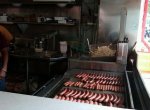September’s end-of-the-month restaurant review is of Ben’s Chili Bowl. A D.C. landmark restaurant, it is located in northwest D.C.’s Shaw neighborhood, next to The Lincoln Theatre, in an historic building at 1213 U Street (MAP). Built in 1910, the building originally housed the city’s first silent movie house, named The Minnehaha Theater. Later, Harry Beckley, one of D.C.’s first Black police detectives, converted it into a pool hall. A family-run business, Ben’s Chili Bowl was originally opened by Ben Ali, a Trinidadian-born immigrant who had studied dentistry at nearby Howard University, and his fiancee, Virginian-born Virginia Rollins. They were married seven weeks after opening the restaurant. Today it is run by their sons, Kamal and Nizam.
From the unrest of the late 1960’s race riots that followed the assassination of Martin Luther King, Jr., to the tough economic times in the 1970’s and 1980’s that resulted from the destruction of much of the neighborhood’s businesses during the riots, and finally to the revitalization and gentrification of the U Street Corridor beginning in the 1990’s, Ben’s has survived and seen it all. Over 50 years later, Ben’s remains as it has always been, right down to the red booths and bar stools and Formica counters, which are the original ones from when the restaurant first opened. Even Ben’s large neon “Home of the Famous Chili Dog” hearkens back to an earlier time.
Locals and tourists, as well as celebrities including Bill Cosby, Chris Tucker and Bono, and politicians such as President Barack Obama and French President Nicolas Sarkozy, have flocked to Ben’s Chili Bowl for decades for its rich history, friendly atmosphere and delicious food. A sign at the restaurant, however, notifies patrons that only Mr. Cosby and the Obama family eat for free.
The menu at Ben’s includes the traditional hot dogs and hamburgers and fries, as well as more recently added healthier choices such as turkey dogs and vegetarian burgers. But I must confess that I have not tried any of these offerings. It seems almost wrong to go to Ben’s and not have what they are most famous for.
Ben’s namesake chili is still made according to the original recipe, and comes complete with chunks of ground beef, green peppers and onions, and is filled with spices to tantalize your taste buds. The chili is available by the bowl, as well as how I prefer it – as a condiment for the hot dogs, French fries, and just about anything else on the menu. But my recommendation is to try “Bill Cosby’s Original Chili Half-smoke.” Originally made famous by Ben’s in 1958 and a favorite of Mr. Cosby’s since the early 1960s, it is a mouth-watering and juicy half-pork and half-beef smoked sausage, topped with their spicy chili, on a warm steamed bun. It is considered not only Ben’s, but D.C.’s signature dish.
Recently, Ben’s Chili Bowl has also expanded by opening a new restaurant and bar called Ben’s Next Door, in addition to outposts at Nationals Park and FedEx Field, Ronald Reagan Washington National Airport, and across the river in Rosslyn neighborhood of Arlington, Virginia. And although the food is the same, there is something about the original location that makes everything just a little bit better. But don’t take my word for it. You don’t even have to believe the prestigious James Beard Foundation, which named Ben’s one of the “down-home eateries that have carved out a special place on the American culinary landscape.” I recommend that you stop by and try it for yourself.


[Click on the thumbnails above to view the full size photos]



















































